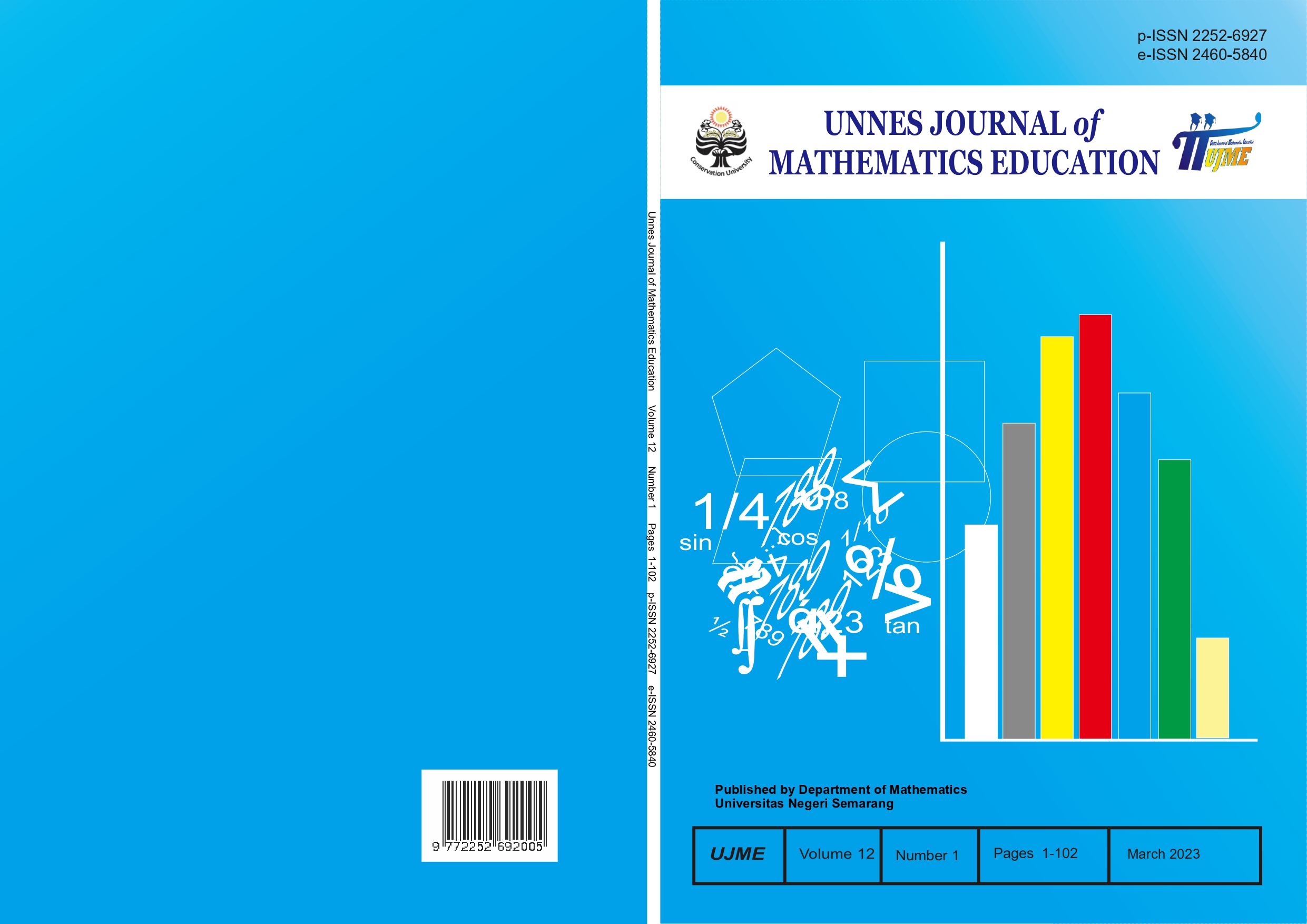Students’ Mathematical Representation Ability in Cooperative Learning Type of Reciprocal Peer Tutoring from Learning Style
##plugins.themes.academic_pro.article.main##
Abstract
This study aims to analyze whether the Cooperative Learning type of Reciprocal Peer Tutoring (RPT) is effective in enhancing students' mathematical representation abilities, whether it is more effective than PBL in enhancing students' mathematical representation abilities, how learning styles influence students' mathematical representation abilities in Cooperative Learning type of RPT, and to describe the ability of mathematical representation in terms of learning styles in Cooperative Learning type of RPT. The research method used was a mixed method, and the design used was sequential explanatory. The sampling technique used was random sampling by class. The results showed that: (1) the ability of mathematical representation in the Cooperative Learning type of RPT achieved classical completeness; (2) the average mathematical representation ability in the Cooperative Learning type of RPT was higher than that of PBL; (3) the proportion of completeness of mathematical representation ability in Cooperative Learning type of RPT was higher than that of the PBL class, indicating that Cooperative Learning type of RPT is more effective in enhancing mathematical representation abilities; and (4) there is a positive influence of learning styles on students' mathematical representation ability in Cooperative Learning type of RPT. Subjects with visual learning styles are able to fulfill visual and verbal indicators and tend to be able to fulfill symbolic indicators. Subjects with auditory learning styles tend to be able to fulfill visual and symbolic indicators but tend to be less able to fulfill verbal indicators. Subjects with kinaesthetic learning styles are able to meet visual indicators.
##plugins.themes.academic_pro.article.details##
References
Allen, Charles E., Mary E. Froustet, John F. LeBlanc, Joseph N. Payne, Anita Priest, Jerry F. Reed, Joan E. Worth, Gladys M. Thomason, Bob Robinson, and Joseph N. Payne. 2020. National Council of Teachers of Mathematics. The Arithmetic Teacher 29 (5): 59. https://doi.org/10.5951/at.29.5.0059.
Astuti, Dina, Ganjar Susilo, and Tri Hariyati Nur Indah Sari. 2018. Pengaruh Konsentrasi Belajar Dan Kemandirian Belajar Terhadap Hasil Belajar Matematika Siswa Kelas XI SMA Negeri 2 Balikpapan Tahun Ajaran 2017/2018. De Fermat : Jurnal Pendidikan Matematika 1 (2): 42–53. https://doi.org/10.36277/defermat.v1i2.25.
Bintartik, Lilik, Yuniawatika Yuniawatika, and Esti Untari. 2018. Learning Style of Grade V Students At Elementary Schools In Blitar. International Research-Based Education Journal 1 (2): 103. https://doi.org/10.17977/um043v1i2p103-107.
Budiningsih, C. A. 2003. Perkembangan Teori Belajar dan Pembelajaran Menuju Revolusi Sosiokultural Vygotsky. Dinamika Pendidikan, 10(1).
Burhanuddin, Azhar. 2017. Tata Kelola Pembelajaran Aktif, Inovatif, Kreatif, Efektif Dan Menyenangkan (Paikem) Di SMA Pondok Pesantren Immim Makassar. Idaarah: Jurnal Manajemen Pendidikan 1 (1): 34–51. https://doi.org/10.24252/idaarah.v1i1.4082.
Creswell, John W. 2009. Research Design Qualitative, Quantitative, and Mixed Methods Approaches. 3rd ed. SAGE aaaapublications, Inc.
Fadillah, S. 2011. Meningkatkan Kemampuan Representasi Multipel Matematika Siswa SMP Melalui Pembelajaran Dengan Pendekatan Open Ended. Jurnal Pendidikan Matematika 2 (2): 100–107.
Fantuzzo, John W., Ron E. Riggio, Sharon Connelly, and Linda A. Dimeff. 1989. Effects of Reciprocal Peer Tutoring on Academic Achievement and Psychological Adjustment: A Component Analysis. Journal of Educational Psychology, 81 (2): 173–77. https://doi.org/10.1037/0022-0663.81.2.173.
Graciella, Misel, and Erna Suwangsih. 2016. Penerapan Pendekatan Matematika Realistik Untuk Meningkatkan Kemampuan Representasi Matematis Siswa. Metodik Didaktik 10 (2): 27–36. https://doi.org/10.17509/md.v10i2.3180.
Hidayati, Sri. 2015. Pembelajaran Kooperatif Dengan Tutor Sebaya Pada Materi Ajar Statistika. Dinamika 05 (3): 1–8.
Khoeron, Ibnu R., Nana Sumarna, and Tatang Permana. 2016. Pengaruh Gaya Belajar Terhadap Prestasi Belajar Peserta Didik Pada Mata Pelajaran Produktif. Journal of Mechanical Engineering Education 1 (2): 291. https://doi.org/10.17509/jmee.v1i2.3816.
Ludji Bire, Arylien, Uda Geradus, and Josue. Bire. 2014. Pengaruh Gaya Belajar Visual, Auditorial, Dan Kinestetik Terhadap Prestasi Belajar Siswa. Jurnal Kependidikan 44: 168–74.
Mandur, K., Sadra, W., & Suparta, I. N. (2016). Kontribusi kemampuan koneksi, kemampuan representasi, dan disposisi matematis terhadap prestasi belajar matematika siswa sma swasta di kabupaten manggarai. Jurnal Pendidikan dan Kebudayaan Missio, 8(1), 65-72.
Purwati, D., Sessu, A., & Jusra, H. (2018). Pengaruh Model Pembelajaran Auditory Intellectually Repetition (AIR) Terhadap Kemampuan Komunikasi Matematis Siswa SMP. Prosiding SENAMKU, 1, 240-249.
Sinaga, Gilbert Febrian Marulitua, Agung Hartoyo, and Hamdani. 2016. Kemampuan Representasi Matematis Siswa Ditinjau Dari Gaya Belajar Pada Materi Fungsi Kuadrat Di SMA. Jurnal Pendidikan Dan Pembelajaran Khatulistiwa 5 (6): 1–12. http://jurnal.untan.ac.id/index.php/jpdpb/article/view/15709/13800.
Sukestiyarno. 2021. Metode Penelitian Pendidikan. 3rd ed. Semarang: Alem Print.
Toshev, B. V. 2014. Mathematics for Teachers and Students: Calculus. Chemistry 23 (3): 340–52.
Usman, Irvan. 2013. Kepribadian, Komunikasi, Kelompok Teman Sebaya, Iklim Sekolah Dan Perilaku Bullying. HUMANITAS: Indonesian Psychological Journal 10 (1): 49. https://doi.org/10.26555/humanitas.v10i1.328.
Wahyuni, Yusri. 2017. Identifikasi Gaya Belajar (Visual, Auditorial, Kinestetik) Mahasiswa Pendidikan Matematika Universitas Bung Hatta. Jurnal Penelitian Dan Pembelajaran Matematika 10 (2): 128–32. https://doi.org/10.30870/jppm.v10i2.2037.
Yudhanegara, Mokhammad Ridwan, and Karunia Eka Lestari. 2015. Meningkatkan Kemampuan Representasi Beragam Matematis Siswa Melalui Pembeajaran Berbasis Masalah Terbuka (Penelitian Kuasi Eksperimen Terhadap Siswa Kelas VII SMPN 1 Pagaden, Subang). Jurnal Ilmiah Solusi 1 (4): 97–106.
